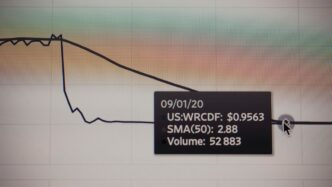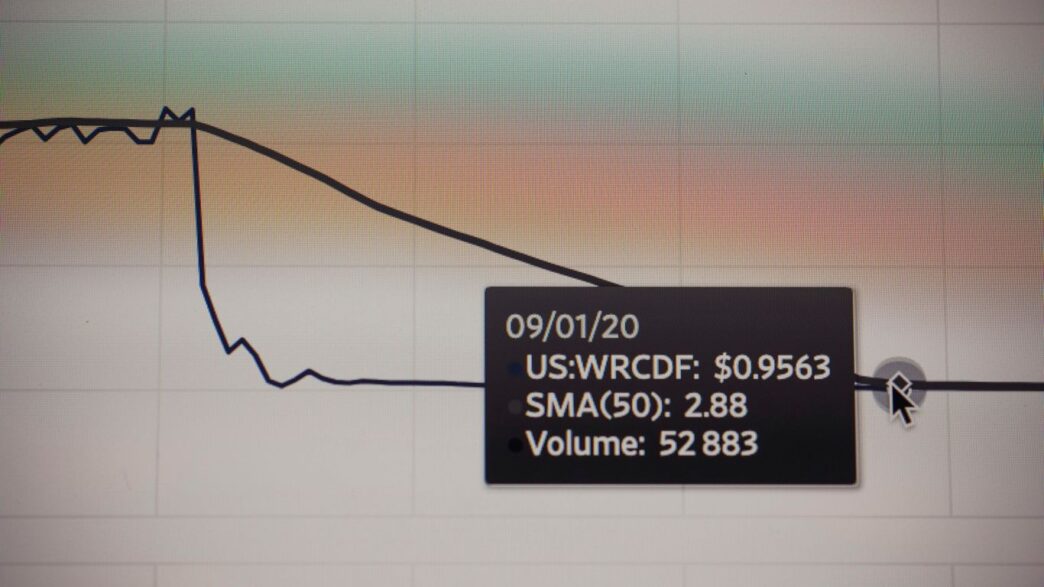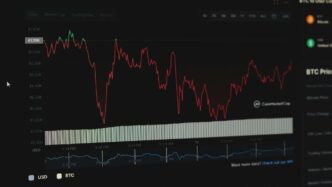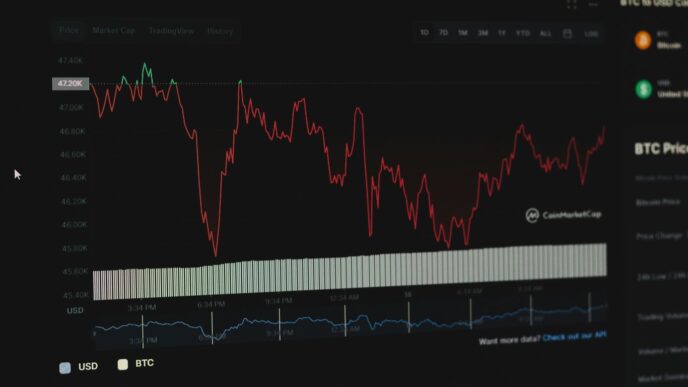Thinking about Visa stocks price? It’s been a bit of a mixed bag lately. The stock saw a small dip recently, but if you zoom out, it’s actually done pretty well over the last year. So, what’s the deal? Is this a chance to buy in cheaper, or is the price already reflecting all the good stuff to come? Let’s break down what’s happening with Visa stocks price and what might be next.
Key Takeaways
- Visa’s stock price has seen a slight pullback recently, but its year-long performance shows strong gains, suggesting a generally positive trend despite short-term fluctuations.
- A significant portion of the market views Visa as undervalued, with fair value estimates often higher than the current stock price, pointing to potential upside.
- Key factors driving a positive outlook for Visa stocks price include the global move away from cash, the rise of e-commerce, and increased use of ‘tap to pay’ and tokenized payment methods.
- While Visa’s growth story is compelling, its stock currently trades at a higher price-to-earnings ratio compared to industry peers, raising questions about whether this premium is fully justified.
- Potential risks to Visa stocks price include growing competition from alternative payment systems and increased regulatory attention, which could impact future profitability.
Understanding Visa Stocks Price Performance

Recent Price Movements and Trends
Lately, Visa’s stock has been doing okay, not exactly setting the world on fire, but not tanking either. On a recent Tuesday, the shares nudged up just a tiny bit, less than 0.1%. There wasn’t any big news to shake things up, so investors were just kind of looking at how it’s been doing and what it might be worth. Over the last month, the stock actually dipped a little, about 1%. It’s like it took a small breath after a decent run earlier in the year.
Year-Over-Year Shareholder Returns
Even with that recent dip, if you look back over the past year, Visa has actually treated its shareholders pretty well. The total return is up a solid 18%. That’s a pretty good number, showing that even when there are small pullbacks, the longer-term picture has been one of steady growth. It suggests that for people looking for a more stable investment that grows over time, Visa has been a good bet.
Short-Term Pullbacks vs. Long-Term Growth
So, what does this recent 1% dip mean? Is it a chance to buy in cheaper, or is the market already pricing in all the good stuff Visa is expected to do? It’s a question a lot of investors are asking. The company has been growing its earnings steadily, and right now, the stock price is still below what many analysts think it should be. This makes it look attractive, especially when you consider the big trends like more people using cards instead of cash and the huge growth in online shopping. These things are good for Visa’s business in the long run. The key is to look past the day-to-day ups and downs and see the bigger picture of how Visa keeps expanding its reach and making more money from transactions.
| Time Period | Performance |
|---|---|
| Last Month | Approx. -1% |
| Last Year | Approx. +18% |
| Previous Week | Approx. -0.13% |
Valuation Narratives for Visa Stocks Price
When we look at Visa’s stock price, there are a couple of main stories people are telling about its worth. Some folks think it’s a steal right now, while others are looking at the numbers and seeing a bit of a stretch.
The Undervalued Perspective
A lot of people are looking at Visa and saying it’s actually cheaper than it should be. The idea here is that based on what Visa is expected to do financially in the future, its current stock price doesn’t quite catch up. For example, one popular view suggests Visa is about 12.7% undervalued. This narrative puts its fair value at around $391.46, which is quite a bit higher than where it was trading recently, around $341.89. This makes the stock look pretty attractive if you believe those future predictions will play out. It’s like finding a good deal before everyone else notices.
Fair Value Estimates and Analyst Targets
So, what’s the actual number analysts are throwing around? Well, as mentioned, one common estimate puts Visa’s fair value at $391.46. This is a pretty significant jump from its recent trading price. It means that if the company keeps growing like expected, the stock has room to climb. Analysts often look at things like earnings growth and how much the company can expand its business to come up with these targets. It’s not just a random guess; it’s based on a lot of number crunching.
Factors Driving Bullish Outlooks
What’s making so many people feel good about Visa’s future? A big part of it is the world moving away from cash. More and more people are using cards and digital payments, and Visa is right at the center of that. Think about how often you use ‘tap to pay’ now – it’s everywhere. Plus, the way payments are secured with things like tokenized credentials is getting better and better. These trends mean Visa can handle more transactions and reach more customers globally. It’s a solid foundation for continued growth. If you’re curious about other companies that might benefit from these trends, you might want to check out fast growing stocks with high insider ownership.
Key Growth Drivers Impacting Visa Stocks Price
So, what’s really pushing Visa’s stock forward? It’s not just one thing, but a few big trends that are changing how we all pay for stuff.
Global Shift Away From Cash
Think about it, fewer people are carrying around wads of cash these days. This global move away from physical money is a massive win for companies like Visa. It means more transactions are happening digitally, and Visa is right there to process them. It’s like the world is slowly but surely ditching the old way of doing things for something quicker and, frankly, easier.
E-commerce Adoption and Digital Payments
Online shopping isn’t just a trend anymore; it’s how a lot of us get our goods. As more people buy things online, they need ways to pay. Visa’s digital payment networks are built for this. They handle the complex stuff behind the scenes so you can click ‘buy’ without a second thought. This growth in online buying directly translates to more payment processing for Visa.
Tap to Pay and Tokenized Credentials Growth
Remember when you had to swipe your card and wait for that beep? Now, you just tap it. This ‘tap to pay’ feature is everywhere, and it’s super convenient. On top of that, Visa uses something called tokenization, which is a fancy way of saying they make your card information safer when you use it online or in apps. These two things, easy tapping and secure payments, are making people more comfortable using cards and digital wallets for everyday purchases. This comfort means more transactions, and more transactions mean good news for Visa’s stock.
Assessing Visa’s Valuation Multiples
Price-to-Earnings Ratio Analysis
When we look at Visa’s stock, one of the first things people check is the price-to-earnings (P/E) ratio. It basically tells you how much investors are willing to pay for each dollar of a company’s earnings. Right now, Visa’s P/E is sitting around 32.8. That might sound high, and honestly, it is when you compare it to other companies. This premium valuation suggests that a lot of the good news about Visa’s future growth might already be factored into its current stock price.
Comparison with Industry Peers
Let’s put that P/E ratio into perspective. The average P/E for companies in Visa’s industry is about 21.5. The broader US Diversified Financial sector averages around 16.1. So, Visa is trading significantly higher than its peers. This isn’t necessarily a bad thing, as Visa is a dominant player, but it does mean investors are paying extra for that position. It’s like buying a premium brand – you expect a certain level of quality and performance, and you’re willing to pay a bit more for it.
Implications of Premium Valuations
So, what does this higher valuation mean for you as an investor? Well, it sets a pretty high bar for Visa to keep delivering strong results. If the company meets or beats expectations, the stock price could continue to climb. However, if growth slows down even a little, or if new competitors pop up, the stock could face more pressure because so much optimism is already built in. It means that any stumbles, no matter how small, could be magnified. For example, the S&P 500 and Nasdaq have seen highs recently, but individual stock performance can vary wildly [1bac]. Investors need to be aware that a high P/E means future returns are heavily dependent on Visa continuing its impressive growth trajectory.
Potential Risks to Visa Stocks Price Outlook
Even with all the good news about Visa’s growth, it’s not all smooth sailing. We need to talk about the bumps in the road that could affect the stock price. It’s easy to get caught up in the positive trends, but looking at the potential downsides is just as important for any investor.
Alternative Payment Network Competition
Visa operates in a space that’s always changing. While they’re a giant, new players and technologies keep popping up. These alternatives, sometimes backed by big tech companies or innovative startups, could chip away at Visa’s market share. Think about how quickly new apps can gain users; the same can happen in payments. If these competitors offer lower fees or a better user experience, it could put pressure on Visa’s transaction volumes and, consequently, its stock. It’s a constant game of staying ahead, and Visa Inc. faces competitive weaknesses in this regard.
Regulatory Scrutiny and Profit Margins
Governments and regulatory bodies around the world are always keeping an eye on big financial companies like Visa. They worry about things like fair competition, data privacy, and how much companies charge for their services. If new regulations come into play, they could limit how Visa operates or force them to change their fee structures. This kind of scrutiny can directly impact their profit margins, which is a big deal for stock performance. It’s a balancing act for Visa to grow while staying on the right side of regulators.
Ambitious Growth Targets and Market Expectations
Visa often sets pretty ambitious goals for itself, and the market usually expects them to hit those targets. When a stock trades at a high valuation, like Visa’s often does, it means investors are already betting on that future growth. For example, Visa’s price-to-earnings ratio can be quite a bit higher than its industry peers. If Visa misses its growth targets, even slightly, or if market expectations become too high to meet, the stock price could react negatively. It’s like setting the bar really high for a gymnastics routine – if you stumble, the score drops significantly. Investors need to be aware that a lot of the current stock price might already reflect optimistic future performance.
Future Projections for Visa Stocks Price
So, what’s next for Visa’s stock? Looking ahead, analysts seem pretty optimistic, with most price targets suggesting there’s still room for growth. The general vibe is that Visa is well-positioned to keep expanding, especially as more of the world moves away from cash and embraces digital payments. It’s not just about credit cards anymore; think tap-to-pay and all that tokenized credential stuff. These trends are big drivers for Visa’s business.
Analyst Forecasts and Price Targets
Most analysts are putting out numbers that show Visa’s stock price could climb higher. For example, some have set a maximum estimate around $430.00, while the lowest they’re predicting is $325.00. This range gives you an idea of what experts are thinking. It’s worth keeping an eye on the Visa Inc. stock price chart to see how it moves relative to these predictions.
Long-Term Revenue and Margin Expansion
Visa’s business model is pretty solid, and they’re expected to see steady growth in revenue over the long haul. A big part of this comes from increasing transaction volumes globally. Plus, they’re working on keeping their profit margins healthy, which is always good news for shareholders. The company’s ability to adapt and innovate in the payment space is key here.
Market Capitalization Trends
When you look at Visa’s market cap, it’s already huge, sitting at around $658.68 billion. While it can fluctuate week to week, the overall trend points towards continued expansion as the company grows. This kind of market size often means more stability, but also means that massive percentage gains might be harder to come by compared to smaller companies. Still, for a company like Visa, consistent growth in market cap is a strong indicator of its ongoing success.
Wrapping Up Our Look at Visa Stock
So, what’s the takeaway after digging into Visa’s stock? It looks like the company is still on solid ground, with a good track record and some clear reasons why people are optimistic. The move away from cash and the rise of online shopping are big pluses for Visa, suggesting more transactions are likely to come its way. While the stock has seen a small dip recently, many analysts still see it as undervalued, pointing to potential for growth. However, it’s not all smooth sailing. Keep an eye on new payment methods popping up and any government rules that might affect things. Plus, Visa’s stock price is already pretty high compared to others in its field, meaning it has to keep hitting those growth targets to justify the cost. Overall, Visa seems like a steady player, but like any investment, it’s wise to watch the trends and be aware of the risks.
Frequently Asked Questions
How has Visa’s stock been doing lately?
Visa’s stock price has seen a small dip of about 1% in the last month. However, over the past year, its value has gone up by a strong 18%. This shows that while there might be small ups and downs, the stock has been growing steadily over a longer time.
Is Visa stock a good deal right now?
Some people think Visa’s stock might be a good buy because its current price is lower than what many experts predict it will be worth. This idea, called the ‘undervalued perspective,’ suggests that the stock could be worth about 12.7% more than it is now.
What makes people think Visa’s stock will keep growing?
Two big reasons are that fewer people are using cash, and more people are shopping online. Also, using ‘tap to pay’ and secure digital codes for payments is becoming super popular. These trends mean more people are using Visa’s services, which helps the company make more money.
Is Visa’s stock expensive compared to other companies?
Yes, Visa’s stock price is higher than many similar companies in its industry. This means investors are paying a premium for Visa, possibly because they expect it to grow faster. It’s important to consider if this higher price is worth it.
What could cause problems for Visa’s stock price?
New types of payment companies could become strong competitors. Also, governments might create new rules that affect how Visa makes money. If Visa doesn’t meet the high expectations investors have, its stock price could be negatively impacted.
What do experts think Visa’s stock will do in the future?
Most experts believe Visa’s stock price will go up. They expect the company to earn more money and become more profitable over the long run. This positive outlook suggests that Visa’s value could continue to grow significantly.














